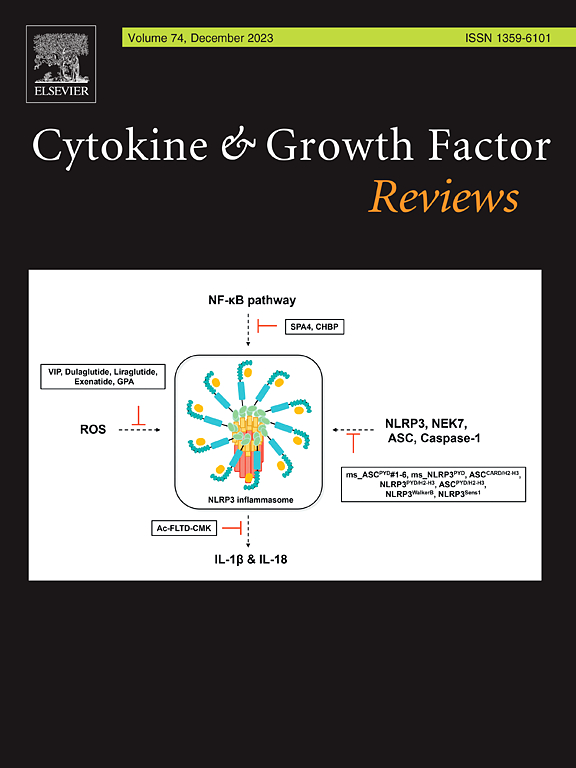TLR4 在 COVID-19 中的阴与阳。
IF 11.8
2区 医学
Q1 BIOCHEMISTRY & MOLECULAR BIOLOGY
引用次数: 0
摘要
包括收费样受体(TLRs)在内的各种模式识别受体(PRRs)在识别入侵病原体以及感染时释放的损伤相关分子模式(DAMPs)方面发挥着至关重要的作用。由此产生的信号级联启动适当的免疫反应,以消灭这些病原体。目前的证据表明,SARS-CoV-2 驱动的 TLR4 激活,无论是通过直接识别尖峰糖蛋白(单独或与内毒素结合),还是通过感知病毒感染过程中释放的各种 TLR4 激活 DAMP 或警报素,都是抗病毒免疫的关键介质。然而,TLR4 在 COVID-19 中发挥着双重作用,既有有益的影响,也有有害的影响。TLR4 信号传导失调与 COVID-19 免疫发病机制相关的促炎后果有关。此外,TLR4 多态性也会导致疾病的严重程度。鉴于 TLR4 对 COVID-19 免疫病理和宿主免疫具有重要的免疫调节作用,它已成为开发抑制剂和免疫治疗策略的关键靶点,以减轻与 SARS-CoV-2 和相关感染有关的不良影响。此外,TLR4 激动剂还被探索用作佐剂,以增强对 SARS-CoV-2 疫苗的免疫反应。本文章由计算机程序翻译,如有差异,请以英文原文为准。
The Yin and Yang of TLR4 in COVID-19
Various pattern recognition receptors (PRRs), including toll-like receptors (TLRs), play a crucial role in recognizing invading pathogens as well as damage-associated molecular patterns (DAMPs) released in response to infection. The resulting signaling cascades initiate appropriate immune responses to eliminate these pathogens. Current evidence suggests that SARS-CoV-2-driven activation of TLR4, whether through direct recognition of the spike glycoprotein (alone or in combination with endotoxin) or by sensing various TLR4-activating DAMPs or alarmins released during viral infection, acts as a critical mediator of antiviral immunity. However, TLR4 exerts a dual role in COVID-19, demonstrating both beneficial and deleterious effects. Dysregulated TLR4 signaling is implicated in the proinflammatory consequences linked to the immunopathogenesis of COVID-19. Additionally, TLR4 polymorphisms contribute to severity of the disease. Given its significant immunoregulatory impact on COVID-19 immunopathology and host immunity, TLR4 has emerged as a key target for developing inhibitors and immunotherapeutic strategies to mitigate the adverse effects associated with SARS-CoV-2 and related infections. Furthermore, TLR4 agonists are also being explored as adjuvants to enhance immune responses to SARS-CoV-2 vaccines.
求助全文
通过发布文献求助,成功后即可免费获取论文全文。
去求助
来源期刊

Cytokine & Growth Factor Reviews
生物-生化与分子生物学
CiteScore
21.10
自引率
1.50%
发文量
61
审稿时长
22 days
期刊介绍:
Cytokine & Growth Factor Reviews is a leading publication that focuses on the dynamic fields of growth factor and cytokine research. Our journal offers a platform for authors to disseminate thought-provoking articles such as critical reviews, state-of-the-art reviews, letters to the editor, and meeting reviews.
We aim to cover important breakthroughs in these rapidly evolving areas, providing valuable insights into the multidisciplinary significance of cytokines and growth factors. Our journal spans various domains including signal transduction, cell growth and differentiation, embryonic development, immunology, tumorigenesis, and clinical medicine.
By publishing cutting-edge research and analysis, we aim to influence the way researchers and experts perceive and understand growth factors and cytokines. We encourage novel expressions of ideas and innovative approaches to organizing content, fostering a stimulating environment for knowledge exchange and scientific advancement.
 求助内容:
求助内容: 应助结果提醒方式:
应助结果提醒方式:


